Anyone ever heard of this? Got it off the ILGM page…
BONUS: Split the stem
There is one method of increasing the yield of your marijuana plants that not everyone knows about — splitting the stem. This will help your plants’ buds be heavier and denser and will improve THC production as well.
This technique is exactly what it sounds like — it involves splitting the stem of your marijuana plant right at the bottom. It likely originated in China and Southeast Asia.
 Split the stem more thc
Split the stem more thc
 Split the stem increase yield
Split the stem increase yield
To be successful with the stem splitting technique, start out by tying the stem right at the base, just above the soil. Tie a second rope or cable tie a couple inches above that. Take a very sharp knife and cut from the top tie to the bottom tie. There should be one vertical cut that is a few inches in length.
The knife should remain inside until you have a pencil, chopsticks, or other objects to replace it with to keep both sides of the marijuana plant from touching each other. Remove the knife partially and rotate it to allow the chopstick or pencil enough space. Leave the ties in place, so the damage does not spread.

The thing about splitting the stem is that it is a tricky technique to master, so you should only try it on one plant per growing season until you are confident you’ve gotten it down. Apply this technique a few days or a week before harvest, not sooner.
Produce more THC
The purpose of stem splitting is to disturb the flow of nutrients and water right at the base of the stem. Because of this, the plant will start producing more trichomes and more THC. Trichomes are responsible for making heavier, denser buds that are just better overall, so you can see why this is a useful technique. All cannabinoids are created in the trichomes.
BONUS: Split the stem
There is one method of increasing the yield of your marijuana plants that not everyone knows about — splitting the stem. This will help your plants’ buds be heavier and denser and will improve THC production as well.
This technique is exactly what it sounds like — it involves splitting the stem of your marijuana plant right at the bottom. It likely originated in China and Southeast Asia.


To be successful with the stem splitting technique, start out by tying the stem right at the base, just above the soil. Tie a second rope or cable tie a couple inches above that. Take a very sharp knife and cut from the top tie to the bottom tie. There should be one vertical cut that is a few inches in length.
The knife should remain inside until you have a pencil, chopsticks, or other objects to replace it with to keep both sides of the marijuana plant from touching each other. Remove the knife partially and rotate it to allow the chopstick or pencil enough space. Leave the ties in place, so the damage does not spread.

The thing about splitting the stem is that it is a tricky technique to master, so you should only try it on one plant per growing season until you are confident you’ve gotten it down. Apply this technique a few days or a week before harvest, not sooner.
Produce more THC
The purpose of stem splitting is to disturb the flow of nutrients and water right at the base of the stem. Because of this, the plant will start producing more trichomes and more THC. Trichomes are responsible for making heavier, denser buds that are just better overall, so you can see why this is a useful technique. All cannabinoids are created in the trichomes.





